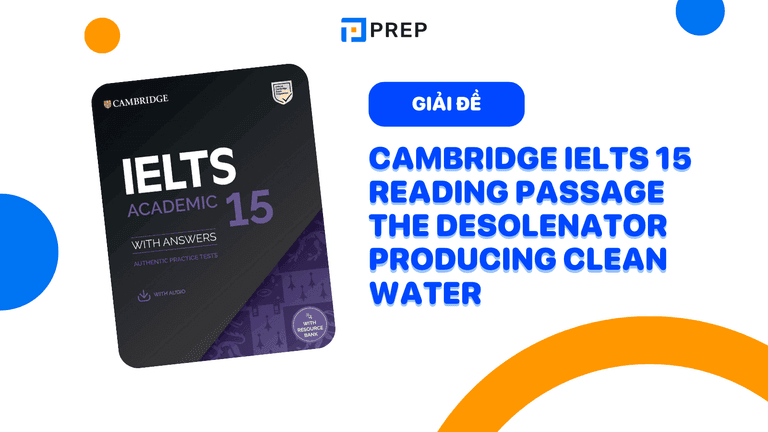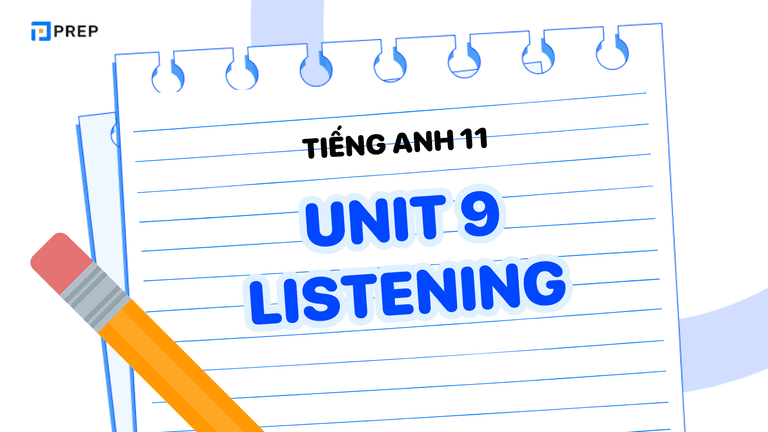Đề bài và đáp án chi tiết Cambridge IELTS 15 Passage 1: The Return of the Huarango
Trong phần Reading của IELTS, nhiều bài tập đề cập đến các vấn đề sinh thái và bảo tồn thiên nhiên. Bài đọc “The Return of the Huarango” trong Cambridge IELTS 15 – Test 4, Passage 1 giới thiệu về cây huarango, một loài cây bản địa tại vùng ven biển phía nam Peru. Trong bài viết sau, cùng Prep tìm hiểu đề bài và phân tích đáp án chi tiết của bài đọc này nhé!

I. Đề bài Cambridge IELTS 15 Test 4 Reading Passage 1 The Return of the Huarango
The return of the huarango
The arid valleys of southern Peru are welcoming the return of a native plant
The south coast of Peru is a narrow, 2,000-kilometre-long strip of desert squeezed between the Andes and the Pacific Ocean. It is also one of the most fragile ecosystems on Earth. It hardly ever rains there, and the only year-round source of water is located tens of metres below the surface. This is why the huarango tree is so suited to life there: it has the longest roots of any tree in the world. They stretch down 50–80 metres and, as well as sucking up water for the tree, they bring it into the higher subsoil, creating a water source for other plant life.
Dr David Beresford-Jones, archaeobotanist at Cambridge University, has been studying the role of the huarango tree in landscape change in the Lower Ica Valley in southern Peru. He believes it was a key to the ancient people's diet and, because it could reach deep water sources, it allowed local people to withstand years of drought when their other crops failed. But over the centuries huarango trees were gradually replaced with crops. Cutting down native woodland leads to erosion, as there is nothing to keep the soil in place. So when the huarangos go, the land turns into a desert. Nothing grows at all in the Lower Ica Valley now.
For centuries the huarango tree was vital to the people of the neighbouring Middle Ica Valley too. They grew vegetables under it and ate products made from its seed pods. Its leaves and bark were used for herbal remedies, while its branches were used for charcoal for cooking and heating, and its trunk was used to build houses. But now it is disappearing rapidly. The majority of the huarango forests in the valley have already been cleared for fuel and agriculture – initially, these were smallholdings, but now they're huge farms producing crops for the international market.
‘Of the forests that were here 1,000 years ago, 99 per cent have already gone,’ says botanist Oliver Whaley from Kew Gardens in London, who, together with ethnobotanist Dr William Milliken, is running a pioneering project to protect and restore the rapidly disappearing habitat. In order to succeed, Whaley needs to get the local people on board, and that has meant overcoming local prejudices. ‘Increasingly aspirational communities think that if you plant food trees in your home or street, it shows you are poor, and still need to grow your own food,’ he says. In order to stop the Middle Ica Valley going the same way as the Lower Ica Valley, Whaley is encouraging locals to love the huarangos again. ‘It's a process of cultural restoration,’ he says. He has already set up a huarango festival to reinstate a sense of pride in their eco-heritage, and has helped local schoolchildren plant thousands of trees.
‘In order to get people interested in habitat restoration, you need to plant a tree that is useful to them,’ says Whaley. So, he has been working with local families to attempt to create a sustainable income from the huarangos by turning their products into foodstuffs. ‘Boil up the beans and you get this thick brown syrup like molasses. You can also use it in drinks, soups or stews.’ The pods can be ground into flour to make cakes, and the seeds roasted into a sweet, chocolatey ‘coffee’. ‘It’s packed full of vitamins and minerals,’ Whaley says.
And some farmers are already planting huarangos. Alberto Benevides, owner of Ica Valley’s only certified organic farm, which Whaley helped set up, has been planting the tree for 13 years. He produces syrup and flour, and sells these products at an organic farmers’ market in Lima. His farm is relatively small and doesn’t yet provide him with enough to live on, but he hopes this will change. ‘The organic market is growing rapidly in Peru,’ Benevides says. ‘I am investing in the future.’
But even if Whaley can convince the local people to fall in love with the huarango again, there is still the threat of the larger farms. Some of these cut across the forests and break up the corridors that allow the essential movement of mammals, birds and pollen up and down the narrow forest strip. In the hope of counteracting this, he’s persuading farmers to let him plant forest corridors on their land. He believes the extra woodland will also benefit the farms by reducing their water usage through a lowering of evaporation and providing a refuge for bio-control insects.
‘If we can record biodiversity and see how it all works, then we’re in a good position to move on from there. Desert habitats can reduce down to very little,’ Whaley explains. ‘It’s not like a rainforest that needs to have this huge expanse. Life has always been confined to corridors and islands here. If you just have a few trees left, the population can grow up quickly because it’s used to exploiting water when it arrives.’ He sees his project as a model that has the potential to be rolled out across other arid areas around the world. ‘If we can do it here, in the most fragile system on Earth, then that’s a real message of hope for lots of places, including Africa, where there is drought and they just can’t afford to wait for rain.’
Questions 1-5
Complete the notes below.
Choose ONE WORD ONLY from the passage for each answer.
Write your answers in boxes 1-5 on your answer sheet.
The importance of the huarango tree
-
its roots can extend as far as 80 metres into the soil
-
can access 1 ............................. deep below the surface
-
was a crucial part of local inhabitants' 2 ............................. a long time ago
-
helped people to survive periods of 3 .............................
-
prevents 4 ............................. of the soil
-
prevents land from becoming a 5 .............................
Questions 6-8
Complete the table below.
Choose NO MORE THAN TWO WORDS from the passage for each answer.
Write your answers in boxes 6-8 on your answer sheet.
Traditional uses of the huarango tree
|
Part of tree |
Traditional use |
|
6 ........................... |
fuel |
|
7 ........................... and ........................... |
medicine |
|
8 ........................... |
construction |
Questions 9-13
Do the following statements agree with the information given in Reading Passage 1?
In boxes 9-13 on your answer sheet, write
TRUE if the statement agrees with the information
FALSE if the statement contradicts the information
NOT GIVEN if there is no information on this
9 Local families have told Whaley about some traditional uses of huarango products.
10 Farmer Alberto Benevides is now making a good profit from growing huarangos.
11 Whaley needs the co-operation of farmers to help preserve the area's wildlife.
12 For Whaley's project to succeed, it needs to be extended over a very large area.
13 Whaley has plans to go to Africa to set up a similar project.

II. Đáp án
Reading Passage 1, Questions 1-13
-
water
-
diet
-
drought
-
erosion
-
desert
-
(its / huarango / the) branches
-
IN EITHER ORDER (BOTH REQUIRED FOR ONE MARK)
-
leaves (and)
-
bark
-
-
(its / huarango / the) trunk
-
NOT GIVEN
-
FALSE
-
TRUE
-
FALSE
-
NOT GIVEN
III. Giải thích đáp án chi tiết
Questions 1-5
-
1. water: Cây huarango có thể hút nước từ độ sâu 50–80 mét, giúp nó sống sót trong điều kiện khô cằn của vùng sa mạc. (Thông tin này có trong đoạn đầu của bài đọc.)
-
2. diet: Cây huarango là một phần quan trọng trong chế độ ăn của người dân địa phương từ lâu, cung cấp nguồn thực phẩm qua các hạt và quả của nó. (Câu này được nhắc đến khi nói về vai trò của cây huarango trong việc duy trì chế độ ăn của người dân cổ đại.)
-
3. drought: Cây huarango cho phép người dân vượt qua các đợt hạn hán kéo dài khi các cây trồng khác không sống sót. (Đây là một phần quan trọng trong lý do cây huarango được coi là cứu cánh trong môi trường khô cằn.)
-
4. erosion: Cây huarango giúp giữ đất và ngăn chặn xói mòn khi rừng bị phá hủy. (Thông tin về xói mòn được đề cập khi nói về việc cây huarango bị thay thế bởi các cây trồng khác.)
-
5. desert: Khi huarango biến mất, đất đai trở thành sa mạc, không thể trồng trọt được gì nữa. (Thông tin này cho thấy mối liên hệ giữa cây huarango và việc duy trì môi trường sống không bị sa mạc hóa.)
Questions 6-8
-
6. branches: Các cành của cây huarango được sử dụng làm than để nấu ăn và sưởi ấm. (Câu này có trong phần đề cập đến các sử dụng truyền thống của cây huarango.)
-
7. leaves and bark: Lá và vỏ của cây huarango được sử dụng trong các bài thuốc dân gian. (Thông tin này giúp mô tả các ứng dụng khác nhau của cây huarango.)
-
8. trunk: Thân cây huarango được sử dụng trong xây dựng nhà cửa. (Đây là một thông tin quan trọng về cách sử dụng các bộ phận của cây huarango.)
Questions 9-13
-
9. NOT GIVEN: Bài đọc không nói rõ ràng các gia đình địa phương đã kể cho Whaley về các sử dụng truyền thống của huarango. (Thông tin này không có trong bài.)
-
10. FALSE: Alberto Benevides chưa tạo ra lợi nhuận tốt từ việc trồng huarango. Mặc dù anh ấy đã trồng cây này trong 13 năm, nhưng chưa có đủ lợi nhuận để sống được từ việc trồng huarango. (Đoạn này nhấn mạnh rằng anh ấy vẫn đang đầu tư vào tương lai.)
-
11. TRUE: Whaley cần sự hợp tác của nông dân để bảo vệ động vật hoang dã trong khu vực, bao gồm việc trồng lại rừng và xây dựng hành lang sinh thái. (Điều này rõ ràng được nhắc đến trong phần về việc thuyết phục nông dân hợp tác.)
-
12. FALSE: Dự án của Whaley không yêu cầu phải mở rộng trên một diện tích rất lớn. Thực tế, ông cho rằng hệ sinh thái sa mạc có thể phục hồi với một diện tích nhỏ, miễn là có đủ cây xanh và hành lang sinh thái. (Thông tin này được nhắc đến trong đoạn cuối khi ông giải thích về sự bền vững của dự án.)
-
13. NOT GIVEN: Mặc dù Whaley có những kế hoạch lớn cho các dự án tương tự ở các khu vực sa mạc khác, bài đọc không nói đến kế hoạch cụ thể của ông ở Châu Phi. (Thông tin này không có trong bài.)
Xem thêm: Đề bài và đáp án chi tiết Cambridge IELTS 15 Reading Passage The Desolenator producing clean water
IV. Từ vựng hay trong bài
|
Từ vựng |
Dịch nghĩa |
Ví dụ |
|
Huarango |
cây huarango – loài cây bản địa ở Peru |
The huarango tree is crucial for desert ecosystems. (Cây huarango rất quan trọng đối với hệ sinh thái sa mạc.) |
|
Arid |
khô cằn |
The region is arid and receives very little rainfall. (Vùng này khô cằn và rất ít mưa.) |
|
Drought |
hạn hán |
Droughts make it hard for people to grow crops. (Hạn hán làm cho việc trồng trọt trở nên khó khăn.) |
|
Erosion |
xói mòn |
Deforestation leads to soil erosion. (Phá rừng dẫn đến xói mòn đất.) |
|
Biodiversity |
đa dạng sinh học |
The huarango tree supports local biodiversity. (Cây huarango hỗ trợ đa dạng sinh học địa phương.) |
|
Sustainable |
bền vững |
Sustainable farming practices are important for the environment. (Các phương pháp canh tác bền vững rất quan trọng đối với môi trường.) |
|
Restoration |
khôi phục |
The restoration of huarango trees is essential for the ecosystem. (Việc khôi phục cây huarango là rất cần thiết cho hệ sinh thái.) |
|
Heritage |
di sản |
The huarango tree is an important part of Peru’s cultural heritage. (Cây huarango là một phần quan trọng của di sản văn hóa Peru.) |
|
Corridors |
hành lang |
Forest corridors help animals move across fragmented landscapes. (Hành lang rừng giúp động vật di chuyển qua các cảnh quan bị phân mảnh.) |

Trên đây là đề bài và đáp án Cambridge IELTS 15 bài đọc The return of the huarango chi tiết. Hy vọng bài viết trên sẽ là nguồn tài liệu hữu ích dành cho các bạn trong quá trình luyện thi IELTS.
Học tiếng Anh online dễ dàng hơn với PREP - Nền tảng Học & Luyện thi thông minh cùng AI. Nhờ công nghệ AI độc quyền, bạn có thể tự học trực tuyến ngay tại nhà, chinh phục lộ trình học IELTS, TOEIC, tiếng Anh giao tiếp hiệu quả. Bên cạnh đó, học viên còn có sự hỗ trợ tuyệt vời từ Teacher Bee AI, trợ lý ảo giúp bạn giải đáp thắc mắc và đồng hành 1-1 trong suốt quá trình học tập. Hãy click TẠI ĐÂY hoặc liên hệ HOTLINE 0931428899 để nhận tư vấn chi tiết về các khóa học tiếng Anh chất lượng nhất thị trường!
Tải ngay app PREP để bắt đầu hành trình học tiếng Anh tại nhà với chương trình học luyện thi online chất lượng cao.

Chào bạn! Mình là Hiền Hoàng, hiện đang đảm nhận vai trò quản trị nội dung sản phẩm tại Blog của website prepedu.com.
Với hơn 5 năm tự học các ngoại ngữ như tiếng Anh, tiếng Trung và ôn luyện một số kỳ thi IELTS, TOEIC, HSK, mình đã tự đúc rút được nhiều kinh nghiệm để hỗ trợ hàng nghìn người đang gặp khó khăn trong việc học ngoại ngữ. Hy vọng rằng những chia sẻ phía trên sẽ giúp ích cho bạn trong quá trình tự ôn luyện thi hiệu quả tại nhà!
Bình luận
Nội dung premium
Xem tất cảLộ trình cá nhân hoá
Có thể bạn quan tâm
Kết nối với Prep
MSDN: 0109817671.
Địa chỉ liên hệ: Tòa nhà Vinaconex, 34 Láng Hạ, phường Láng, TP Hà Nội.
Địa chỉ kinh doanh: Lô 21 C2 Khu đô thị Nam Trung Yên, phường Yên Hòa, TP Hà Nội.
Trụ sở: Số nhà 20, ngách 234/35 đường Hoàng Quốc Việt, phường Nghĩa Đô, TP Hà Nội.
Phòng luyện ảo - Trải nghiệm thực tế - Công nghệ hàng đầu.
Hotline: 0931 42 8899.
Trụ sở: Số nhà 20, ngách 234/35 đường Hoàng Quốc Việt, phường Nghĩa Đô, TP Hà Nội.
Giấy chứng nhận hoạt động đào tạo, bồi dưỡng số 1309/QĐ-SGDĐT ngày 31 tháng 07 năm 2023 do Sở Giáo dục và Đào tạo Hà Nội cấp.























